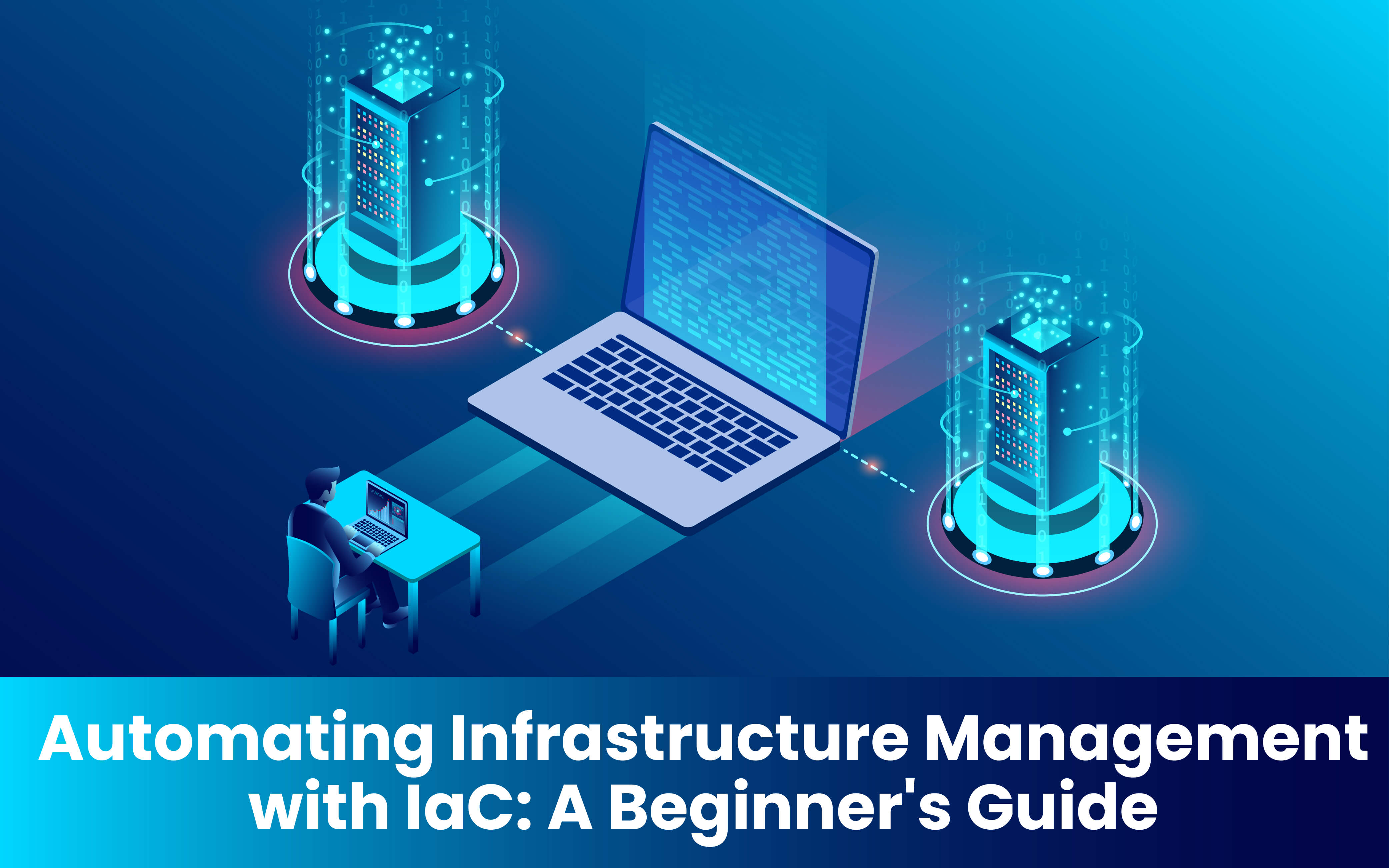Blogs
To know about all things Digitisation and Innovation read our blogs here.
DevOps
Automating Infrastructure Management with IaC: A Beginner’s Guide
SID Global Solutions
24 April 2023

Introduction
Infrastructure as Code (IaC) is a software development practice that allows DevOps teams to automate the provisioning and management of infrastructure resources using code. IaC has become an essential component of modern software development, enabling organizations to build and deploy applications more efficiently and effectively.
In this guide, we will explore the fundamentals of IaC, including the benefits of using it, the tools and technologies available for implementing IaC, and best practices for getting started.
Also Read: How AIOps and DevOps Enable Successful Digital Transformation?
Benefits of IaC
The adoption of IaC can bring a number of benefits to organizations, including:
- Improved Efficiency: By automating infrastructure management, DevOps teams can reduce the time and effort required to provision and configure resources. This can free up time for more important tasks, such as software development.
- Greater Consistency: IaC ensures that infrastructure resources are configured in a consistent manner across environments, reducing the likelihood of errors and misconfigurations.
- Increased Agility: With IaC, DevOps teams can quickly and easily provision resources on demand, enabling them to respond quickly to changing business needs.
- Better Collaboration: IaC promotes collaboration between developers and operations teams, as they can work together to define infrastructure resources and configurations.
- Improved Security: By using code to define infrastructure resources, organizations can implement security controls more easily and consistently, reducing the risk of security breaches.
Tools and Technologies for IaC
There are a number of tools and technologies available for implementing IaC. Some of the most popular include:
- Terraform: An open-source tool developed by HashiCorp, Terraform allows organizations to define infrastructure resources and configurations in a declarative language. It supports a wide range of cloud providers, including Amazon Web Services (AWS), Microsoft Azure, and Google Cloud Platform (GCP).
- AWS CloudFormation: A native IaC tool provided by AWS, CloudFormation enables users to define infrastructure resources and configurations using YAML or JSON templates. It supports a wide range of AWS services and features.
- Ansible: An open-source automation tool developed by Red Hat, Ansible enables users to define infrastructure configurations and execute tasks across multiple systems in an idempotent manner. It can be used to manage both on-premises and cloud-based infrastructure.
- Puppet: Another open-source automation tool, Puppet allows users to define infrastructure configurations and manage resources across multiple environments. It supports a wide range of operating systems and cloud platforms.
- Chef: An open-source configuration management tool, Chef enables users to define infrastructure configurations and automate the deployment and management of resources across multiple environments.
Also Read: How GitOps improves software development and deployment processes?
Choosing the Right Tool
Before implementing IaC, it is important to choose the right tool for your organization’s needs. Factors to consider include the cloud provider you are using, the complexity of your infrastructure, and your team’s skillset.
For example, if your organization uses AWS and requires a tool that supports a wide range of AWS services and features, AWS CloudFormation may be the best option. If your organization uses multiple cloud providers or requires a tool that supports a wide range of operating systems and cloud platforms, Terraform or Puppet may be more suitable.
Defining Your Infrastructure
Once you have chosen an IaC tool, the next step is to define your infrastructure and resource requirements. This involves identifying the resources you need to provision, such as virtual machines, storage volumes, and network configurations, and specifying how they should be configured.
It is important to take the time to carefully define your infrastructure requirements, as this will ensure that your IaC implementation is effective and efficient. This may involve working with other teams, such as network or security teams, to ensure that infrastructure configurations meet their requirements.
In general, it is best to define infrastructure requirements in a modular and reusable manner. This means breaking down resources into smaller, more manageable components that can be reused across different environments and configurations. This can help to reduce the complexity of your infrastructure and make it easier to manage.
Creating IaC Code
With your infrastructure requirements defined, the next step is to create the IaC code. This involves writing the code that will automate the provisioning and management of your infrastructure resources.
In general, IaC code should be written in a declarative manner. This means specifying what resources should be provisioned and how they should be configured, rather than the steps required to provision them. This approach can make it easier to understand and manage infrastructure configurations, and reduce the likelihood of errors and misconfigurations.
In addition to defining resource configurations, IaC code can also include logic for managing resource dependencies and creating reusable components. This can help to further reduce the complexity of your infrastructure and make it easier to manage.
Also Read: Exploring The Key Processes Running In (Kubernetes) K8s Cluster
Testing and Deployment
Before deploying your IaC code, it is important to test it thoroughly to ensure that it works as expected. This may involve using tools such as unit testing frameworks or infrastructure testing tools, such as InSpec or ServerSpec.
Once your IaC code has been tested and validated, it can be deployed to your target environment. This can typically be done using a CI/CD pipeline, which automates the process of building, testing, and deploying code.
Managing IaC Infrastructure
Once your IaC infrastructure is deployed, it is important to manage it effectively. This involves monitoring the performance and availability of your infrastructure resources, and responding quickly to any issues or errors.
In addition to monitoring, it is important to regularly review and update your IaC code to ensure that it remains up-to-date and effective. This may involve making changes to resource configurations or updating IaC tool versions.
Best Practices for IaC
To ensure that your IaC implementation is effective and efficient, it is important to follow best practices. Some best practices to consider include:
- Defining infrastructure requirements in a modular and reusable manner.
- Writing IaC code in a declarative manner.
- Testing IaC code thoroughly before deployment.
- Automating the deployment of IaC code using a CI/CD pipeline.
- Monitoring the performance and availability of IaC infrastructure.
- Regularly reviewing and updating IaC code to ensure that it remains up-to-date and effective.
Conclusion
Infrastructure as Code (IaC) is a powerful tool for automating infrastructure management in modern software development. By defining infrastructure resources and configurations using code, DevOps teams can provision and manage infrastructure resources more efficiently and effectively.
Also Read: How Microservices Are Enabling Digital Transformation for Businesses?
To implement IaC effectively, it is important to choose the right tool, define infrastructure requirements in a modular and reusable manner, write IaC code in a declarative manner, test code thoroughly before deployment, and automate deployment using a CI/CD pipeline. By following best practices and continuously reviewing and updating IaC code, organizations can ensure that their infrastructure is secure, scalable, and efficient.









